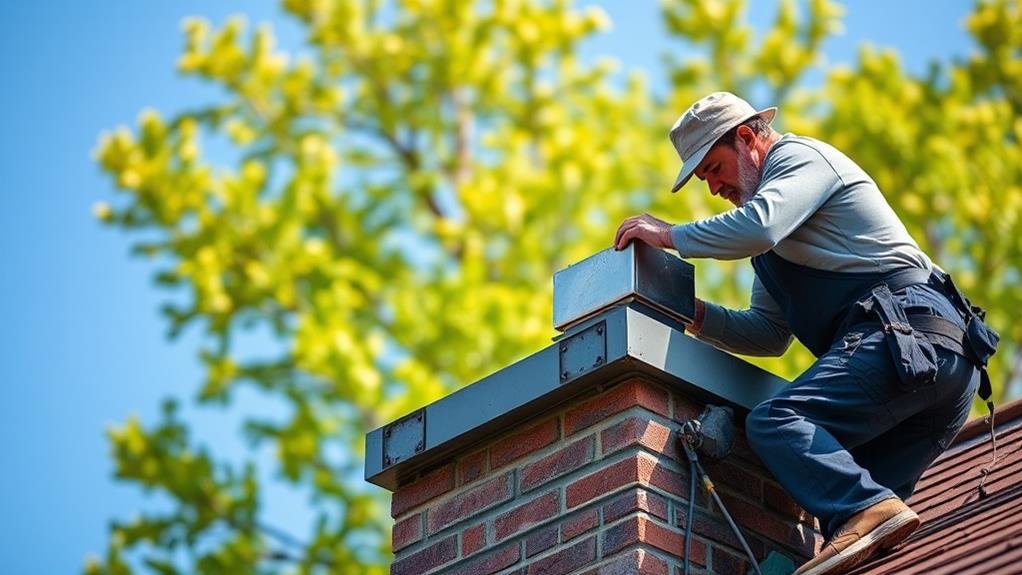To repair a chimney cap in Richmond Hill, Ontario, you need to inspect the existing cap for cracks, rust, or missing sections. Start by removing debris and cleaning the area with a stiff brush or putty knife. If the damage is extensive, replace the cap with a new one made from durable materials like stainless steel or copper. Secure the new cap with appropriate fasteners and apply waterproof sealant around the edges for enhanced moisture protection. Regular inspections and prompt repairs are essential to prevent structural issues and costly damage. Continuing, you'll uncover more details on selecting the right materials and ensuring chimney integrity.
Identify Damage
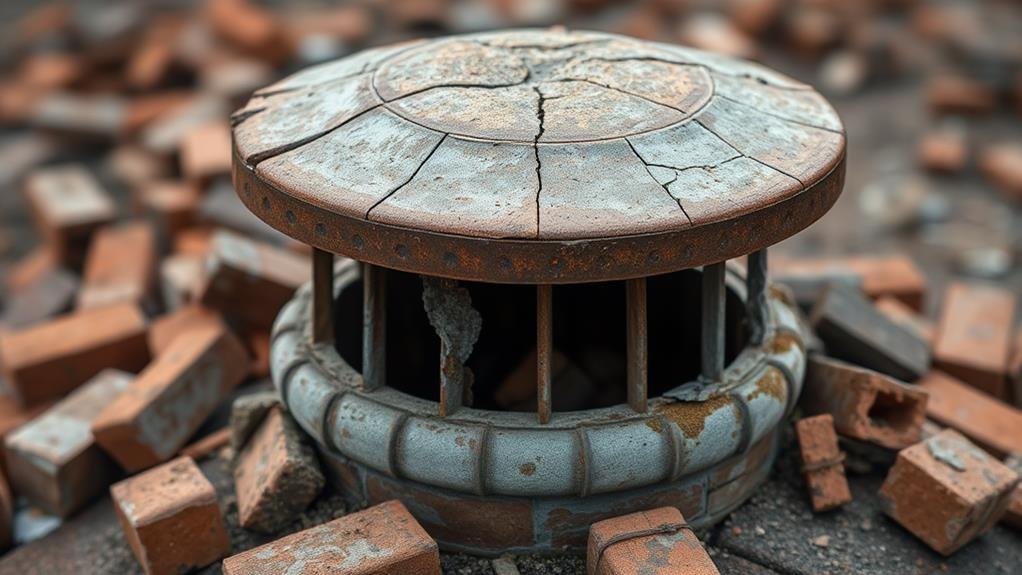
Identifying Damage to Your Chimney Cap
You need to inspect your chimney cap regularly to guarantee it remains effective and safe. Visible cracks, rust, or corrosion on the cap indicate damage that can compromise its performance. Check for gaps between the cap and the chimney structure; these gaps suggest that the cap might be loose or improperly fitted.
Water pooling on the cap's surface is another red flag, indicating that it mightn't be sloped correctly, which could lead to water intrusion.
To inspect the cap thoroughly, use a flashlight to examine its underside for any signs of soot or debris buildup. This buildup can hinder proper ventilation and indicate trapped moisture, which can cause further damage.
Additionally, look for signs of deterioration in the mortar or flashing around the cap. These issues can contribute to leaks and further damage.
Early identification and repair of these problems can prevent more serious issues from developing. Regular inspections and timely repairs are essential for the longevity and safety of your chimney.
Remove Debris
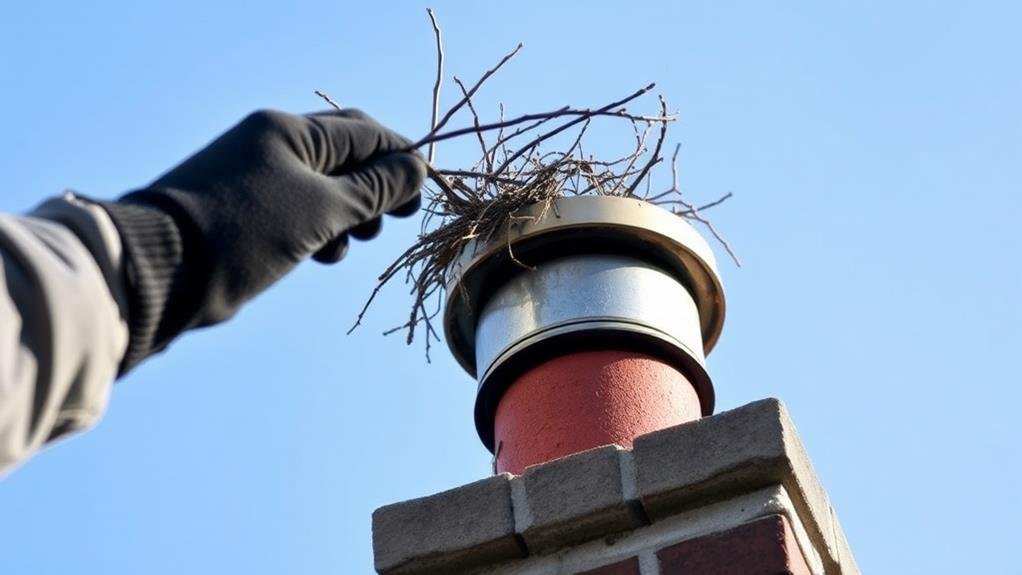
Before you can inspect or repair your chimney cap, you need to confirm the area is completely clear of debris such as leaves, twigs, and dirt. This step is essential because accumulated debris can prevent a thorough inspection and make it difficult to identify any damage or wear on the cap.
To clear the area safely, use a sturdy ladder and always wear appropriate safety gear, including gloves and a hard hat.
Once you're securely positioned, remove all visible debris from the chimney cap. Regularly doing this can prevent water accumulation, which may lead to deterioration of the chimney cap and surrounding structures.
After removing the debris, inspect the cap for any signs of damage or wear. This is important because such findings can indicate underlying issues that need immediate attention.
Confirm you dispose of any collected debris properly, as it can contribute to chimney blockages if left unattended. By clearing the debris, you confirm a more accurate and effective inspection and repair process.
Clean the Area
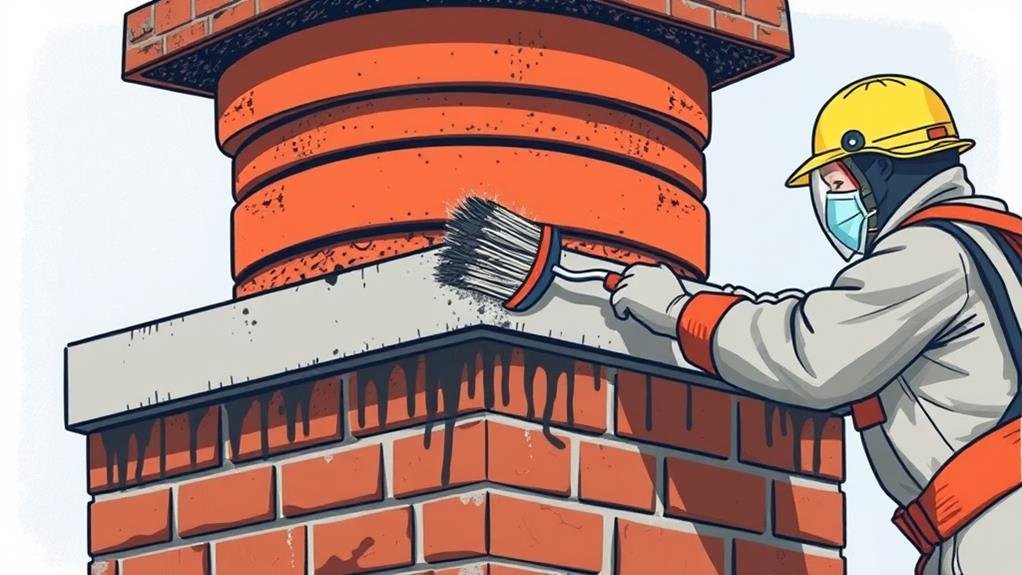
To effectively clean the area around your chimney cap, start by thoroughly brushing away any soot, creosote, or dirt that has accumulated. Use a stiff brush or putty knife to scrub any stubborn buildup, focusing on the cap and surrounding areas.
As you clean, inspect the chimney cap for any signs of damage or deterioration. This will help you identify necessary repairs to guarantee your chimney remains safe and functional.
While cleaning, also verify that the flue is clear of obstructions. A blocked flue can lead to inadequate ventilation and potential safety hazards, so it's essential to check for any blockages.
Once you've cleaned the area and inspected the chimney cap, consider applying a waterproof sealant to help prevent future moisture intrusion and extend its lifespan. This proactive step can save you from costly repairs down the line.
Replace the Cap
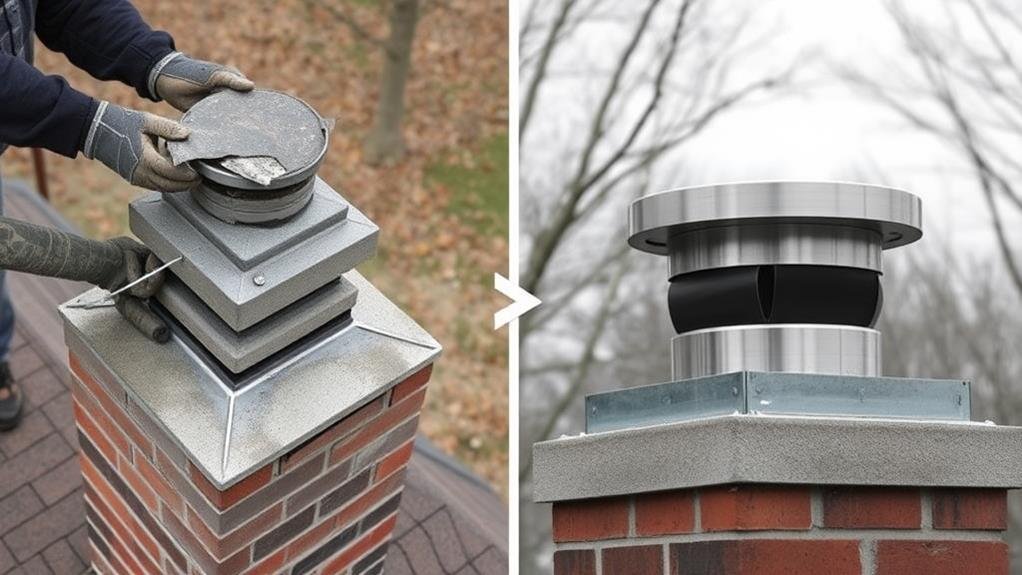
Replacing the Chimney Cap
Replacing the chimney cap is a critical step in guaranteeing the longevity and safety of your chimney. First, inspect the existing cap for damage, carefully looking for cracks, rust, or missing sections that may compromise its effectiveness.
Next, measure the dimensions of the chimney flue to guarantee the new cap fits properly and securely, preventing water and debris from entering the chimney.
Choose a durable material for the new cap, such as stainless steel or copper, which can withstand harsh weather conditions in Richmond Hill.
Install the new cap by securing it with appropriate fasteners, making sure it's tightly fitted to avoid any gaps that could allow water penetration.
Consider applying a waterproof sealant around the edges of the cap to enhance protection against rain and moisture infiltration.
Secure With Sealant
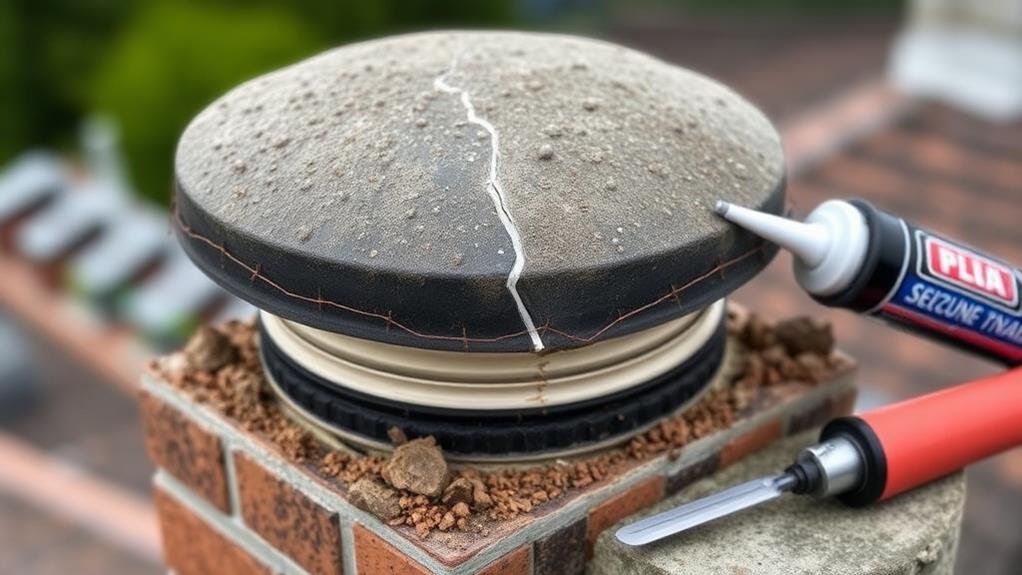
Secure With Sealant
Once you have successfully installed the new chimney cap, it's time to focus on securing it with a suitable sealant. This step is essential to guarantee that the cap stays in place and prevents water from seeping into the chimney structure.
To secure the chimney cap effectively, you first need to clean the area thoroughly to remove any debris or old sealant. This guarantees a proper bond between the new sealant and the chimney surface.
Next, select a high-quality silicone or polyurethane sealant designed for outdoor use. These types of sealants are durable and can withstand weather elements, providing a long-lasting solution.
Apply the sealant evenly around the base of the chimney cap, guaranteeing it fills any gaps. Then, press the chimney cap firmly into place, allowing the sealant to create a watertight barrier once it cures.
Prevent Water Infiltration
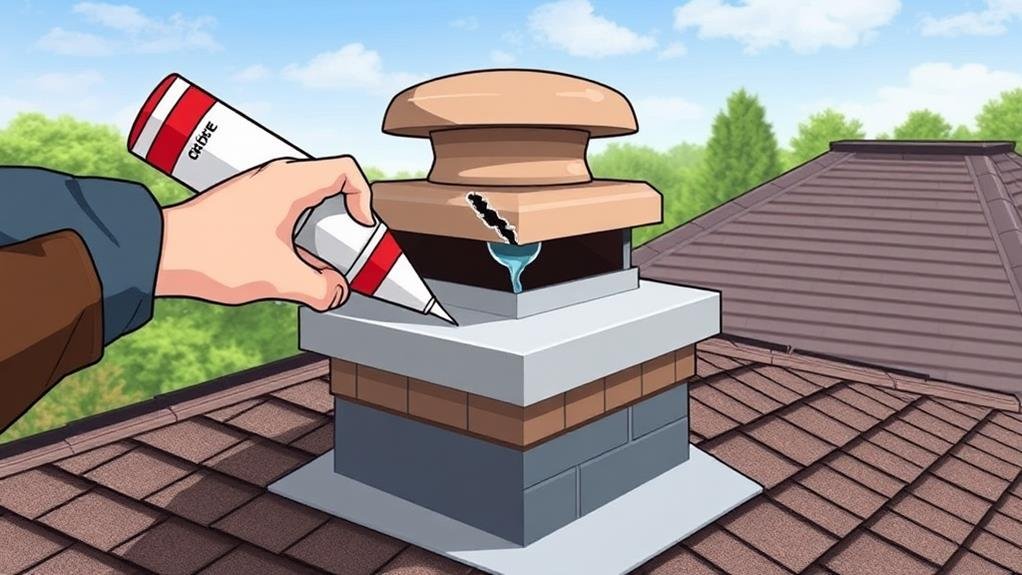
By sealing off the chimney flue with a well-installed cap, you create a formidable barrier against rain and snow, effectively shielding your chimney structure from costly water damage.
Regular inspections are vital to guarantee the chimney cap remains intact and functional. Cracks or gaps in the cap can compromise its effectiveness, allowing moisture to seep through and cause deterioration over time. To prevent this, it's important to use durable materials such as stainless steel or copper for your chimney cap, as these materials are resistant to rust and offer long-lasting protection against water infiltration.
Installing a cap with a mesh screen adds an additional layer of protection by preventing debris and animals from entering the chimney, which can cause further water damage and blockages.
Failing to repair or replace a damaged chimney cap can lead to significant structural issues, emphasizing the importance of prompt action. By addressing any issues promptly and using the right materials, you can safeguard your chimney and prevent costly repairs down the line.
Regular maintenance is key to guaranteeing the longevity and integrity of your chimney.
Schedule Regular Inspections
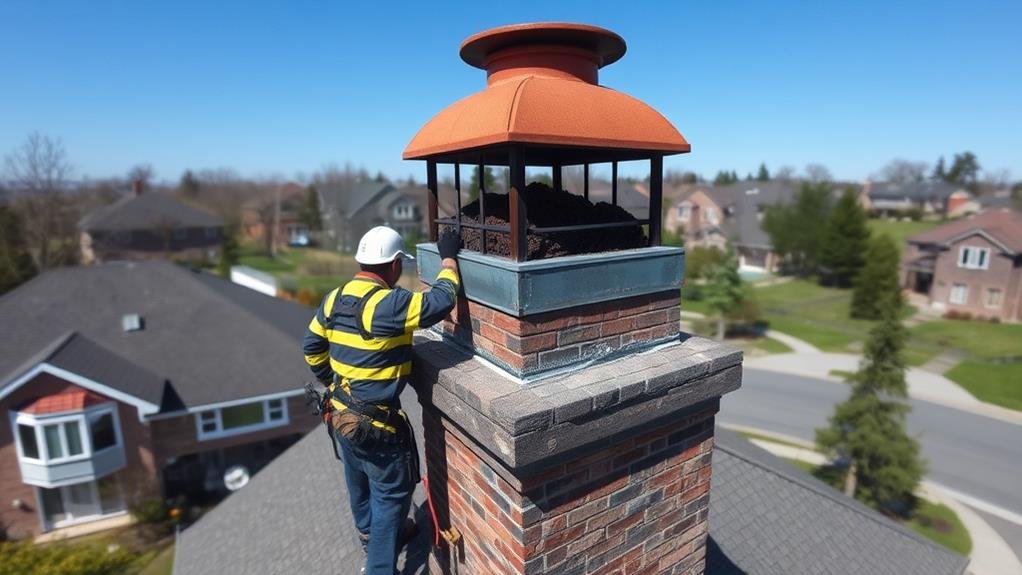
Regular inspections are vital in maintaining the integrity and longevity of your chimney cap. By scheduling these inspections at least once a year, you can identify potential issues before they escalate into costly repairs.
A professional chimney inspector can assess the integrity of the cap, checking for cracks or deterioration that could lead to water intrusion and subsequent damage.
Early detection is critical because minor issues with the chimney cap can lead to significant structural damage if left unaddressed. For example, cracks can allow water to seep into the chimney, causing erosion and weakening the structure.
Regular inspections help guarantee proper ventilation, which is important for preventing smoke buildup and maintaining air quality in your home.
Local chimney repair services often offer extensive inspection packages that include a thorough check of the chimney cap alongside other components.
Choose Durable Materials
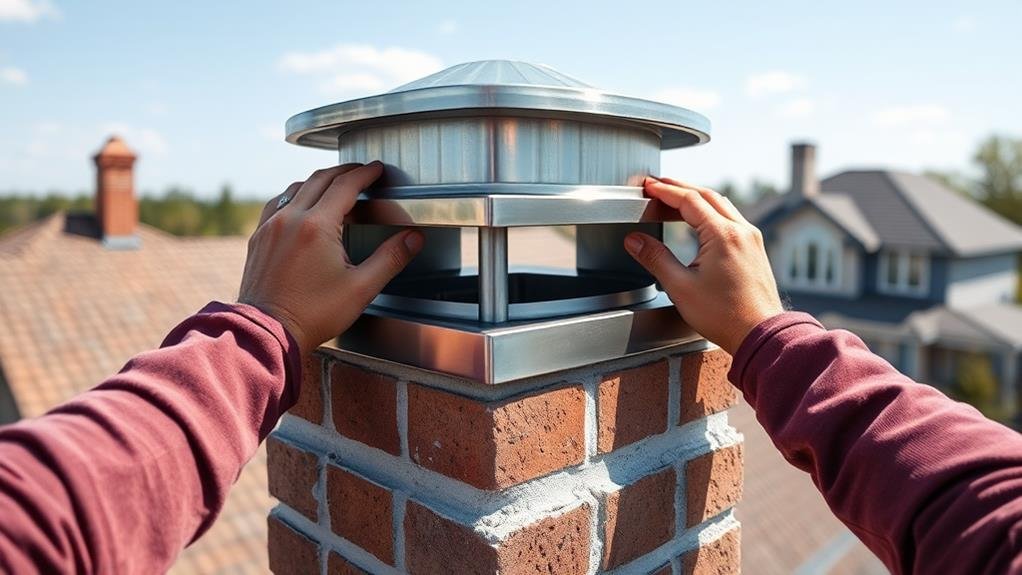
When it comes to repairing your chimney cap, selecting the right materials is key to guaranteeing durability and longevity. You'll want to opt for materials that can withstand the harsh Canadian climate, which includes choosing stainless steel or copper for the chimney cap itself. These materials are resistant to rust and corrosion, providing a solid foundation for a long-lasting repair.
High-quality concrete or masonry materials also play an essential role in chimney cap repairs. They offer better insulation and waterproofing, preventing moisture intrusion and extending the life of the chimney cap.
Consider using materials with a warranty or guarantee, as these can provide reassurance of durability and performance against the elements.
Additionally, confirm that any sealants or adhesives used in the repair are specifically designed for high-temperature applications to withstand the heat from the chimney. A cap with a built-in mesh screen is also a good choice, as it prevents animals and debris from entering the chimney while allowing proper ventilation.
Ensure Chimney Integrity
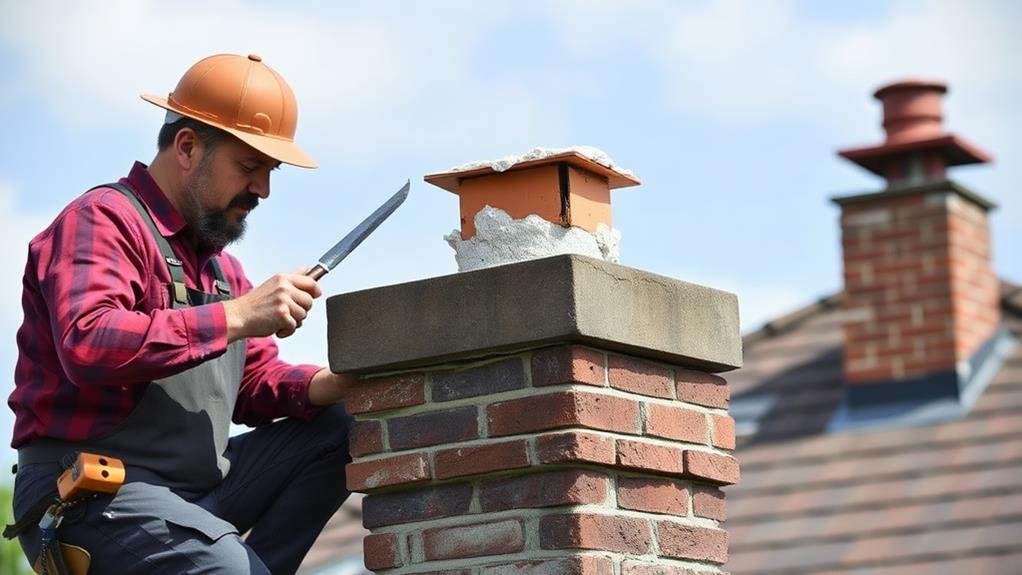
Your home's chimney plays an essential role in guaranteeing the safe and efficient ventilation of smoke and gases. Over time, cracks or deterioration in the chimney cap can compromise its integrity, leading to water intrusion and other issues. Regular inspections can help identify these problems early on.
To maintain chimney integrity, it's vital to inspect and repair the cap as needed. A well-maintained chimney cap prevents debris accumulation, which can obstruct airflow and cause smoke backdrafts. Confirming the cap is properly sealed can also prevent leaks that may lead to significant roof damage and costly repairs down the line.
Using durable materials for cap repairs, such as stainless steel or copper, enhances longevity and performance, reducing the need for frequent maintenance. Additionally, regular maintenance of the chimney cap contributes to improved air quality within the home by guaranteeing efficient smoke ventilation and reducing the risk of chimney fires.
Frequently Asked Questions
How Do You Fix a Chimney Cap?
To fix a chimney cap, you'll assess it for cracks or wear, remove the damaged cap carefully, clean the area thoroughly, and install a new cap that fits properly, sealing it to prevent leaks.
How Do You Put a Chimney Cap Back On?
To put a chimney cap back on, you'll start by positioning it over the flue, ensuring a snug fit. Then, secure it with masonry adhesive and screws or anchors if needed, following the manufacturer's instructions carefully.
How Do You Seal a Chimney Cap Crack?
To seal a chimney cap crack, you'll clean the area around the crack, apply a high-quality exterior caulk or sealant specifically designed for masonry, fill the crack completely, and smooth it out with a putty knife.
How Do I Know if My Chimney Cap Is Bad?
You'll know your chimney cap is bad if you notice visible cracks or chips, rust or corrosion on metal caps, water pooling, excessive debris, a decrease in draft, or increased smoke backflow when using the fireplace.
In Closing
Repairing your chimney cap in Richmond Hill, Ontario, is a critical task that requires attention to detail. By following the steps outlined – identifying damage, removing debris, cleaning the area, replacing the cap, securing it with sealant, and preventing water infiltration – you can guarantee your chimney operates safely and efficiently. Regular inspections and durable materials are key to maintaining chimney integrity. A well-maintained chimney cap not only protects your home but also saves you from costly future repairs.

